- Moffat Takadiwa, The Occupation of Land, 2019, computer keys, toothbrush heads, plastic bottle tops; courtesy of the artist and Nicodim Gallery, Los Angeles/Bucharest; photo: Lee Tyler Thompson
- Moffat Takadiwa, The Occupation of Land, 2019, plastic bottle tops, computer keys, (detail) ; courtesy of the artist and Nicodim Gallery, Los Angeles/Bucharest; photo: Lee Tyler Thompson
Jenan Taylor returns to her southern African roots, drawn by the mysterious smell of soap, to discover the place where Zimbabwe’s iconic sculptor gathers his materials and community.
(A message to the reader.)
It’s late 2019. From my laptop on my kitchen table in Melbourne, I’m browsing an exhibition taking place on the other side of the world. I catch sight of two towering tapestries. Named The Tengwe Farms, their soils, a curious blend of red and green, look like hundreds of taut microscopic suns studding the valleys and rims of larger suns. Recognition dawns when I inspect the small nubs and something perfumes my memory, just a trace, really, but the soap-like redolence is austere enough to make me pull back and point my mouse elsewhere on the canvasses.
A blue avenue near the western edge of one, I take to be river rapids. A vast gold plain on the other I assign the role of crops, maybe maize, maybe sunflowers. The tapestries, part of an exhibition, Son of the Soil by Zimbabwean artist, Moffat Takadiwa, include pieces such as Land of Coca Cola and Colgate, The Green-Gold and Occupation of Land. They are so mesmerising that the hefty topics they examine—land ownership and consumer culture—almost come as a shock. Looking at the draperies is like gazing back at Earth from the uppermost atmosphere. But go closer, much closer, and you soon realise all is not as it seems. Everything they are made of has already been something else: a bottle top, a cap, a toothbrush. I am entranced and I am perplexed.
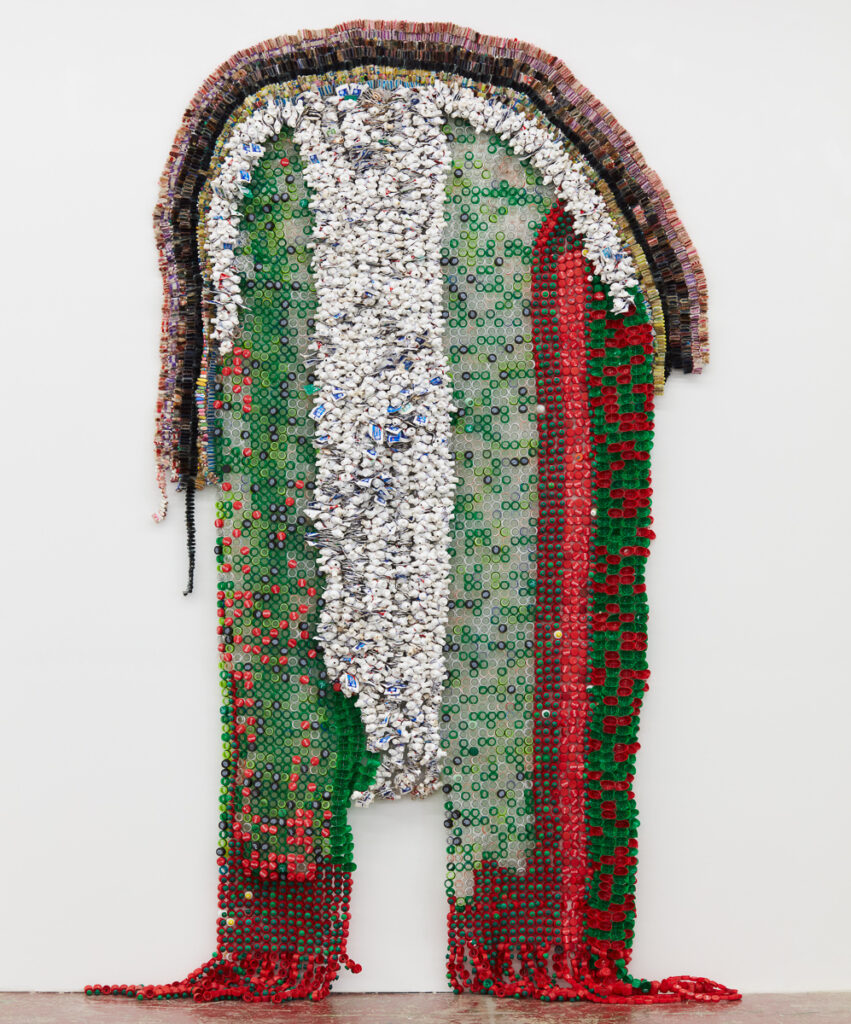
Moffat Takadiwa, Land of Coca-Cola and Colgate, 2019, toothpaste tubes, toothbrush heads, plastic bottle tops; courtesy of the artist and Nicodim Gallery, Los Angeles/Bucharest; photo: Lee Tyler Thompson
In contrast to these assemblages, most of the sculptures my family own are made of copper, timber and soapstone, items they had collected at various points along the Zambia-Zimbabwe border, near Livingstone, where for several years in the 1960s and 70s my South-African born parents worked as teachers. These pieces, a large bird, two elephants, a thumb piano, small spear, a couple of plaques and a heavy, elongated sculpture with two heads, later followed us from Livingstone to Cape Town, and then again, years later, to Melbourne.
Sometimes, though, I still get a whiff of the past. The elephants and bird indicate they might have been cocooned with my father’s whiskey bottles in the packing crates. The thumb piano and the copper plaques resurrect every Christmas I’ve ever known because they’ve absorbed the Brasso my mother has taken to them with over the years in the December clean-up. And my favourite, the elongated double-faced sculpture, takes me back to 1976. It is, like the others, a serene decorative piece that gives away nothing about the mayhem that was unfolding about us back then.
Zambia was widely known as a haven for freedom-loving activists, including those resisting Rhodesia’s White hard-line approach. Years of rumbling had led it to shut its borders with Rhodesia who retaliated with a series of attacks on people at frontier towns. The grown-ups in my life questioned the nature of the people on the other side of the Victoria Falls. The terms, “guerillas”, “terrorists” and “freedom fighters” often dusted their conversations.
Naturally, my parents were nervous—enough to prompt them to move back to South Africa where they would once again have to accept the race classification of Cape Coloured. Lately, I’ve come to realise that the timber sculpture gives nothing away about its maker, either. None of the objects do. I wonder about the carvers and metalworkers all along the troubled frontier, a minuscule cohort in comparison to the numbers around the tourist areas these days. Who were they? If we know what they knew then, what would we see?
It is 40 years since Zimbabwe gained independence and Robert Mugabe came to power, just four since he was removed, seemingly without too much fuss, and less than a year has passed since the country’s liberator died. In all the international media coverage over the years, most of the focus has been the nation’s impoverished state and changing injustices, caused by the corruptions of Mugabe and before him, Ian Smith. If anything has seemed fixed, it is that sculpture is considered a strong part of Zimbabwean culture.
This visual arts tradition is thought to be linked to the country’s abundant granite resources and the ancient decorative objects carved from rock that archaeologists have found in some places. In colonial times, the idea that the population’s ancestors had the knowledge and capabilities to master such unyielding material, appeared to irk the British overlords. In the nation’s more recent art annals, the locals’ inventiveness with stone, which for whatever reason was silenced for hundreds of years, was reawakened because of the intervention of Frank McEwen, the first director of the National Gallery of Zimbabwe. He and a small band of other outsiders encouraged local Africans who showed promise, to use their “natural” abilities with stone. All this was, of course, replete with controversies. Another thing McEwen and others famously required of the students was that they adhere to things they might be “more familiar with”, such as spirituality, mysticism and domestic life.
Mixed media works are by no means new to the country, either. For instance, Tapfuma Gutsa, possibly the country’s preeminent visual artist, has championed merged mediums for at least three decades. He started off with stone materials but his experiences both in and outside the continent led him toward a kind of renaissance in his work. Gutsa has created objects that often combine bone, metal, stone, clay, timber and eggshells in the service of discovering other ways of communicating through objects. A great number of Zimbabwe’s visual artists of note, including Georgina Maxim and Masimba Hwati, use found materials. I have been following theirs as well as other objects created by The Tengwe Farms artist, Moffat Takadiwa, online for months now. Certainly, what I see, read and hear so much about seems to speak a whole different language to that of the past.
What could this shift to visual objects fashioned from the degraded and the discarded indicate about Zimbabwe’s sculpture traditions and the place?
Perhaps the biggest legacy, so far, of a Coloured childhood in the shadow of apartheid in southern Africa, is that issues of domination and social justice, and the contexts in which they unfold, are what drive me. They’ve undoubtedly played a role in my eventually becoming a journalist in Australia, work that’s also been a cover for trying to understand my new home better, and where I might fit in, an on-going project. Perhaps because of that, I have not been back to Africa for years, which is why the chance to examine Zimbabwe in light of a visual arts culture, is one I can’t pass up.
Stone, timber and garbage
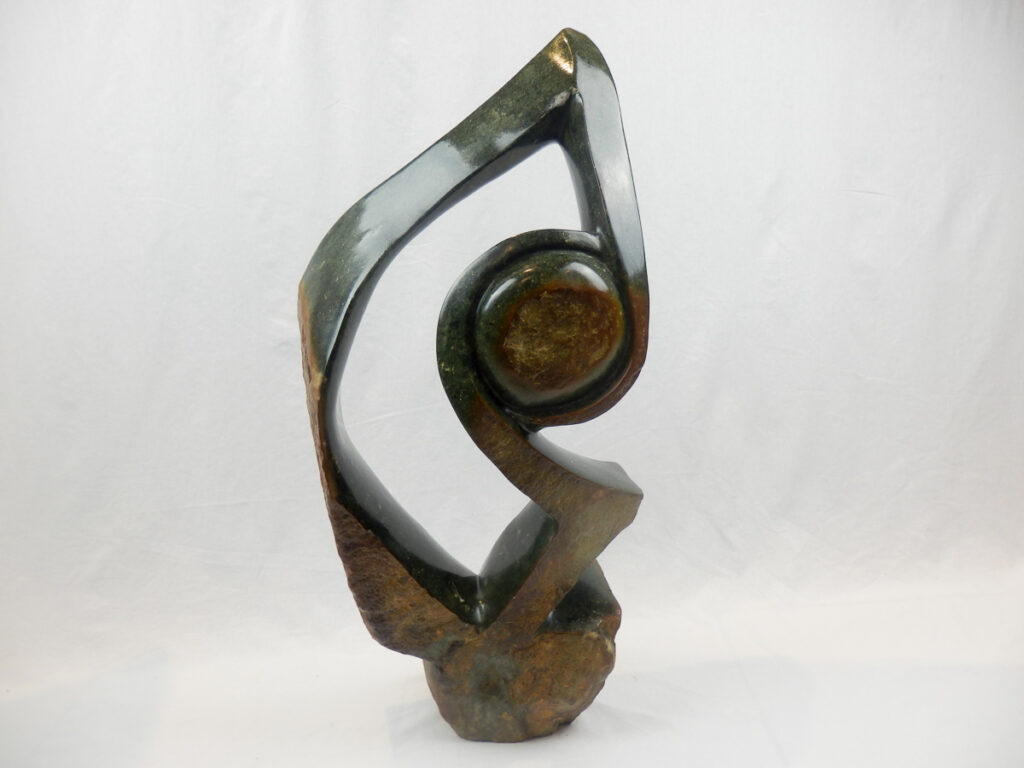
Dudzai Mushawepwere, World In My Hands, (front) Green Opal Stone, PHOTO- Brett McKenzie
Dudzai Mushawepwere, a visual artist since 1990, is pleased to explain what practising traditional sculpture means for him.
He works in Chitungwiza, Zimbabwe, where he carves elegant abstracts from spring stone, verdite, soapstone or dolomite, that perhaps obscure the sweating effort it takes to create them. Although the stone is readily available, it necessitates travel to quarries to excavate the material, usually by pickaxe, and then select the right chunk, something which can take months, even years, depending on what is to be carved. Mushawepere’s frozen spires and waves have centred on themes including HIV AIDS, cancer, orphans and familial bonds. A recent piece, World in Our Hands, made of green opal stone, seems to point toward environmental concerns or even the delicate role we all play in the Covid-19 outbreak.
The artist’s work attracts clients from across Europe and Australia and includes former Western Australia Premier Richard Court. But the truth is, he was driven by material necessity to become a sculptor, a difficult livelihood in Zimbabwe, so Mushawepwere depends on sculpture teaching tours every year to the UK.
He learnt how to carve as an apprentice to a friend and sees himself always sculpting in stone because that’s how he will pass on what he knows to the next generation. It is an important part of the culture that takes years, a long rite of passage, really, that formal art and craft courses just can’t provide, Mushawepwere says, “But maybe it’s time to dabble with a bit of mixed media,” he tells me via telephone.
Maybe it’s the mountain, Cape Town’s own massive chunk of stone slap bang in the middle of the city that pulls me, but it seems inconceivable to go to southern Africa without calling in to the “Mother City”, so it becomes my first stop.
Godfrey Chimhanzi, a Zimbabwean sculptor, lives in a coastal suburb on the eastern side of the Peninsula. He left Zimbabwe almost 20 years ago in search of financial stability.

Godfrey Chimhanzi with The Chicken Seller sculpture at his workshop
In his sawdust-filled workroom at the back of the surfboard shop, he’ll chop, cut and sand a single timber log for months until it becomes a water peddler or a chicken seller, whose clothes flail as the itinerant passengers he carries in a basket over his shoulder leap squawking and free on to the sideboards and benches of his workshop. “He was just passing through the village, but now young children run around laughing at the chickens and maybe they will help him get them back in the basket.”
A persistent story-teller, sculpture is a chance for Chimhanzi to regale memories of growing up in rural Zimbabwe. He used to sculpt in soapstone but with that lacking in Cape Town, has turned to timber, usually, recycled timber. Being an artist wasn’t what he’d had in mind as a boy. But when it became clear he would never get into engineering, he followed the suggestions of friends and decided to channel his talent into carving.
Unlike Mushawepwere, Chimhanzi isn’t fond of the abstract, but their themes unite in spotlighting domestic lives, even if his sculptures are finely detailed explorations of rural archetypes. That’s what his customers prefer, he says. “They don’t want the political, they just don’t need that in their lives too.” Getting his figurines marketed and sold in a highly competitive tourist precinct like Cape Town, is stressful. More and more artists arrive from other provinces and other African countries every day, and when they’re desperate to make sales they’ll undercut wherever they can.
The issue of who would be the vessel for all he knows has also been on his mind. There is a deficit of female artists in traditional sculpture, but Chimhanzi was quite happy to pass on his love for the art to his daughters. However, he says they had other interests and their lives in South Africa are quite different to what they might have been in pastoral Zimbabwe. So Chimhanzi is relieved that his young son has taken to learning sculpture.
The sculptors’ works also manifest what I imagine to be a kind of spirituality: a deep focus that comes from having their hands regularly vibrate with the labour of hammering through stone, timber or whatever medium they select. In surrendering to it, they not only master the material, they also imbue their work with a form and sheen borne out of contemplation that goes beyond mere observation of subject matter.
One blustery afternoon, by the South African National Gallery in Cape Town’s Company Gardens, I finally come face to face with a Takadiwa object. It is part of Materiality—a pan-African showcase of the unique elements visual artists use to pursue weighty questions including environmentalism and transgenderism. Components challenge the use of traditional paints, metals and stone, and breathe new life into objects.
I’m still reeling from the metallic sculpture of a soldier baby, and a rendition of a shattered aeroplane windscreen pieced together from the shredded passports of the deceased passengers when I round the corner to Mr Consumer 2 (2014).
Composed of liquid soap and soft drink bottle tops, spray can debris and a brush from industrial broom head, it looks alternatively like an enlarged human heart complete with ventricles and dangling aorta, and a dazzling sea creature. What’s remarkable is that some of the hanging tubes or tentacles look organic, which in contrast to what they comprise, is all the more interesting. They appear as seamless, engineered carapaces.
I realise I have noticed similar colours, patterning, those circular and radial shapes before, at least from observing television documentaries. They could be the luminescent flora and fauna of the Great Barrier Reef. From one angle they are healthy corals. From another, they are swirling with detritus that in combination with vinegary seas, will soon be leached of their vitality.
In thinking of how the object has managed to spark thoughts of ecological concerns important to my own geographic context, I’m reminded of points made by curator and art historian Valerie Kabov. Drawing attention to the cosmologies used in much of the work of some of the continent’s contemporary artists, she says that the geometric shapes and patterning stitched into the textiles recall knowledge systems and design particular to African communities.
“Importantly, however, their chosen medium and format are able to translate potently to a global audience far beyond their own cultural and geographic context, in a way that speaks to a shared humanity rather than a divided one. Articulating the elemental, submerged in a massive global, each artist elevates deeply human concerns in ways that are at once intimate and political.”
Harare
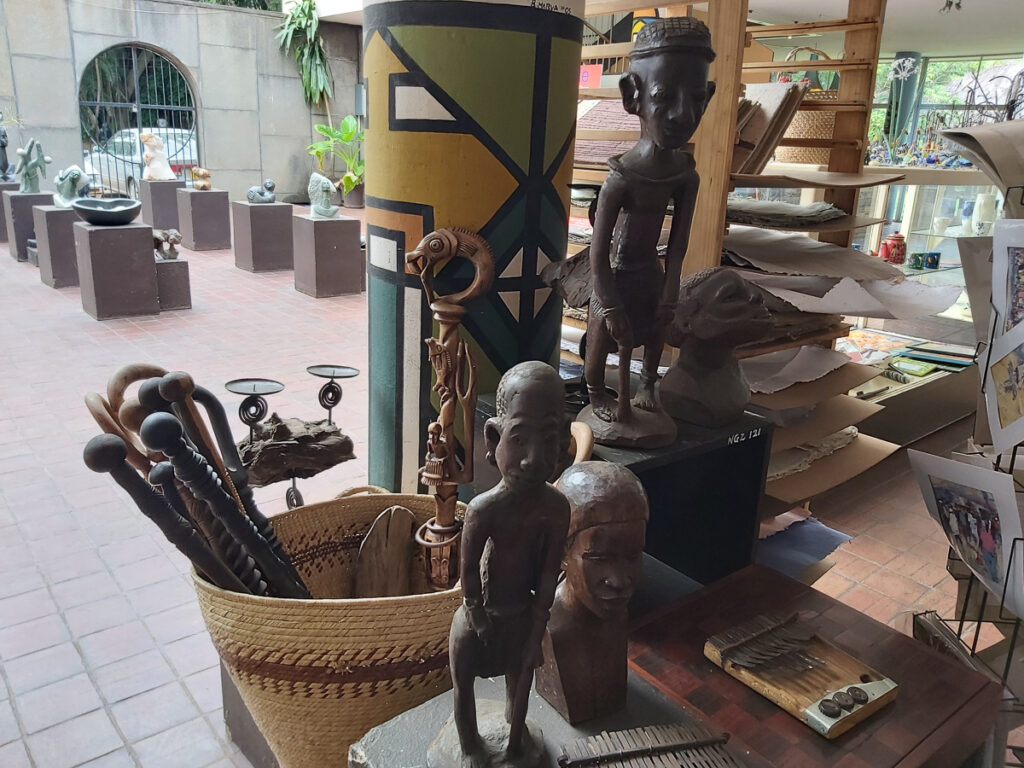
Various artists, National Gallery of Zimbabwe, Objects often included in Culture Box
The National Gallery of Art in Harare is a long rectangular slab of a building that sits at the junction of a wide road that leads off an even broader thoroughfare. What releases the building from its indifferent colonial air are the hopeful street traders lounging at a respectful distance from the stone effigies fronting it, the Jacaranda tree and sculpture-lined gardens abutting it, and the diverse displays bursting inside it.
Raphael Chikukwa, the gallery’s curator, is among the many people who have helped raise the profile of his country’s artists by promoting their work at various international fairs. Several stunning masks each composed of dark wood and featuring delicate scarification indents, adorn the room where we meet late one afternoon. They look on as Chikukwa explains to me how jettisoning the “outsider art” image that came with the legacy of imperialism, is one in a long list of the gallery’s goals.
Like so many institutions in a similar position, reclaiming stolen artefacts is another. Then there’s finding a way to deal with the machine’s dismantlement of traditional cultures. “For many countries, language is their culture. You only have to look at Wales. The older generation of Welsh is very bitter about what’s happened to their language. English is not their language.
“Here in Zimbabwe, the colonialists introduced what they call ‘standard Shona’ to cover all our languages—fourteen or fifteen—with just one language. There are no Shona people. There are Korekore, Karangai, Tonga, Namibia, and so on. They decided to standardise everything, and we are suffering from that now.”
The Culture Box, an idea started by the gallery’s former director, Doreen Sibanda, has been a very popular tool, Chikukwa says. It is a kit of artefacts including headrests, cooking sticks, ceremonial axes, musical instruments, clay pots and other objects. It is loaned out to school students to interact within whichever language they are comfortable with.
I tell him there are at least a hundred ways those experiences echo what’s happened in Australia, and he agrees.
Born-free
Moffat Takadiwa is not apologetic about tussling with a large canvas, especially when it comes to highlighting issues about language, colonialism and oppression. He regards it, in some ways, as his birthright.
Even so, he never expected that it would involve foraging for material for his projects. “But that’s what our lecturers told us. They were kind of tough,” the 37-year old tells me over morning tea one Sunday. “No matter what, we just had to bring them work.” It was 2006, and food, electricity and money shortages had hit a high. It was calamitous for a nation that less than ten years earlier had been called Africa’s “bread-basket”. The then college student had little choice. He went looking for Zimbabwean-made materials, but found a surfeit of Chinese products: Zimbabwe was importing just about everything.
“At that time we were indigenising our country. That was the focus of the government who was saying we are shifting from the west, we are indigenising, we will no longer depend on other people. But the trash was saying the opposite. We may be very indigenised and believe in ourselves but our excretes showed we live on foreign trash. Other people were dumping things on us. That was how I started.”
Later in the day, Takadiwa will be heading overseas, family and work in tow. They’ll be travelling an eye-watering distance: Harare-Johannesburg-Dubai-London-New York-Los Angeles and back. Just a week earlier I was in a similar position and head-achy with all the last-minute arrangements, so I’m moved that he has found a way to come and meet. He doesn’t appear head-achy, but he does take a long sip of tea the moment our order arrives.
Takadiwa is angular and elegant, sports a small corona of dreadlocks, and has a quiet speaking manner accented with the vernacular of his Korekore heritage.
It’s a heritage whose techniques, along with a range of other Zimbabwean ethnic and indigenous traditions, he includes in his work.
This might mean integrating weaving into the massive textiles, the kind that might be found in the design of Korekore winnowing baskets. Characteristically, the patterns repeat themselves over and over, usually, but not always, in a circular fashion.
He describes how he integrated this circularity in constructing Joypad (2014). The game-console shaped piece is one of Takadiwa’s favourites, but also, “Joypad was a monster,” in terms of technique. A meaty 30 centimetres in thickness, it immediately conjures up thoughts of two hemispheres, East and West. The West side comprises silver metal outlining a densely packed ring of gold around a richly coloured gumdrop-like middle, while the East is mostly silver around a decidedly less dynamic centre.
The work came about when Takadiwa noticed the sheer volume of perfume aerosol cans dumped in the areas he and his team frequent. After collecting them, they started to find a way to remove the tops, which involved a unique hammering style, a process in which the metallic caps managed to retain a largely intact look. It took two months.
When he uses computer keys in his work, he usually drills holes in them so they can be threaded, but perfume cans have a straw through them. This made it possible to bunch and tether them with fishing line, thereby creating more and more bunches until he was able to form the structure he wanted. All the time he was conscious of the fabrication referencing traditional configuration to reinforce what he intended, conceptually.
In Korekore design, he adds, “there is a lot of writing in the fabrication about dancing patterns, seasons, counting and mathematics, and so on. There is language and a narrative in the fabrication.” This is particularly important for him because it challenges the western aesthetic and gives young people in Zimbabwe a chance to see themselves beyond the standards set by Europeans.
The results, like Joypad, are sweeping creations that have drawn comparisons to haute couture fashion, beaded jewellery, Persian carpets, even rare and beautiful husks shed by animals. Devoid of anthropomorphic appearance, these fluid quilts summon much discussion about issues beyond their hybrid make-up. It’s no wonder shows like The Armory, where he is headed, want them. But so much of this adulation comes from elite art industry insiders and international publications, like Frieze and The New York Times, set in the global North. How do locals, the ordinary Zimbabweans, respond to his work?
Takadiwa looks at his cup and pauses, and there is a great deal in that short silence.
Visual art is still growing in Zimbabwe and most people either don’t have access to it, or don’t go to museums and galleries because they associate them with colonial times, he explains after this deliberation. “So, I haven’t done a major show here in Zimbabwe for five or six years. It’s too tough. But there’s a growing audience on social media.”
However, he isn’t going to stop and he doesn’t want to leave Zimbabwe. The solution, he decided, was to move to where he gets materials and inspiration.
Mbare
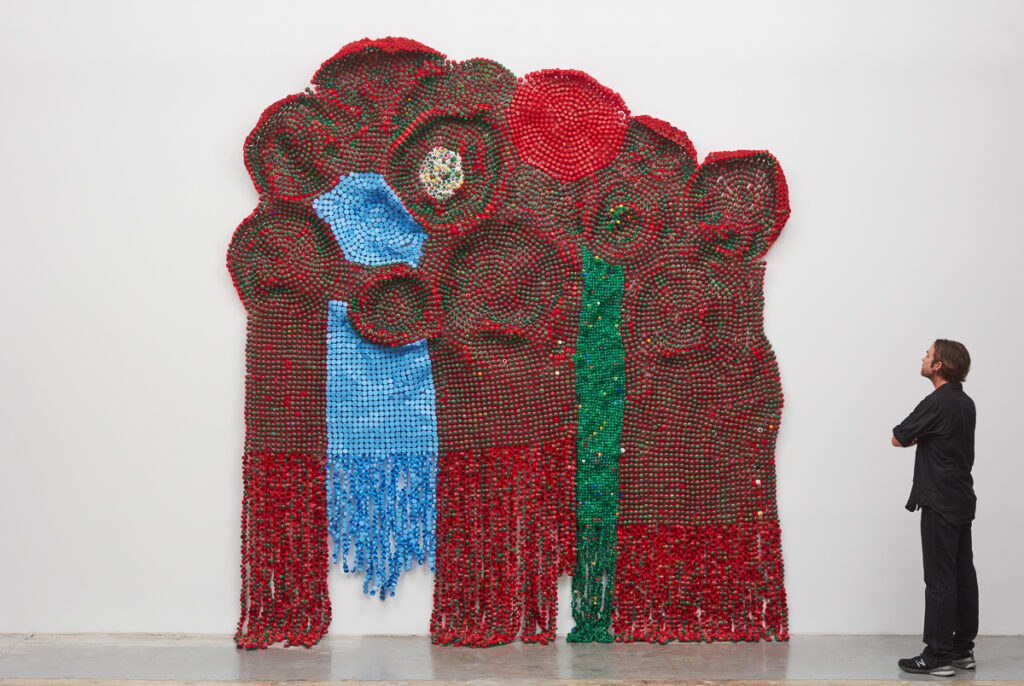
Moffat Takadiwa, The Tengwe Farms 2019 (a), plastic bottle tops (scale); courtesy of the artist and Nicodim Gallery, Los Angeles/Bucharest; photo: Lee Tyler Thompson
The suburb of Mbare, estimated population 800,000, sits south-west of the city and was once the domain of resistance leaders and political rallies. Now it’s the kind of place people who don’t live there write to newspapers to complain about. Mbare is bordered by a cemetery on one end and one of the continent’s biggest tobacco auction houses on the other. In the middle a bus terminus, where all the major roads in the country seem to meet, is filled with the cacophony of idling buses, people from rural villages or from across borders, and the ever-present formal and informal traders from whom it’s said you can get just about anything, from a freshly buffed coffin to a single broken sandal.
A dusty reserve next to rows of old flats glints with broken glass when the sun is at the right angle or thickens with sludge when heavy rain hits the waste heaps openly dumped there. But it is just that spot, and the banks of a lanky river near the town’s outskirts, that a great many people, including artists, scour for plastic, clay, metal, rubber, nylon, anything that just might conceivably turn into gold.
Several of the city’s homeless live among the garbage and spend their days hunting for trash to sell or are commissioned to look for certain recyclable materials. Because of his work, Takadiwa has met a lot of these garbage collectors. “Many are now part of my team and have become friends and we have managed to help some find houses, pay rent, and send their children to school.”
The speed of urban life gives little time for anyone to immerse themselves in the outer areas where some of the traditional crafting activities continue, but with the constant influx of rural people to places like Mbare, Takadiwa has seen an opportunity to extend his knowledge of other ethnicities. In Mbare he’s watched many people doing a lot of other kinds weaving, which he also borrowed from and integrated into his work. This is important because it provides a way to communicate a broader variety of traditional information to a wider variety of people.
Like Tapfuma Gutsa and chimurenga musician, Thomas Mapfumo, from whom he draws inspiration, Takadiwa takes the view that everyday people and their everyday things inform his work, so he should give back where he can, beyond his own projects. For him, this includes being a founding member of the Mbare-based Harare Creative Precinct, launched as part of a plan to revitalise the township through art, culture and tourism.
Being a creative in Zimbabwe is not easy— for many the universal problem of how to earn a living, is frequently overshadowed by harassment from authorities.
Still, some of the precinct’s projects embrace taking outsiders to see another side of Mbare, a place where brilliant murals celebrate childhood, where craft makers and artists show off products like pottery, sculpture, painting and basketry, and where the country’s rising music and film creatives churn out work. The commune also holds workshops such as art therapy and mindfulness for the hundreds who battle mental illness and symptoms of post-traumatic stress disorder.
All this recalls the southern African social philosophy of ubuntu/unhu, which recognises the interconnectedness between living things and the value in nurturing these relations for a more harmonious existence. I see this rooted in Takadiwa’s composite fabrications as much as in his work at the Harare Creative Precinct.
Indeed, the quarter is where the artist has his studio, and that is also how local people get to find out about his work, he says.
I’m curious as to what the neighbourhood people think his objects are, so I ask him if any of his stuff could be adapted outside the gallery.
“I guess they can be usable”, he says. “That’s why they can be hanged in so many different ways. Some people may decide they want to see them being worn. But they are mostly used in displays. I need to think of them being non-functional first.”
Visitors who drop by his studio are likely to find a few finished and still-in-progress works blazing from exposed brick walls, draped over work tables or stretched across mats, while if the weather’s agreeable, the different elements, the aerosol canisters, toothbrushes and the like might be heaped in large gleaming batches under trees in the courtyard.
Takadiwa also loves music and usually plays it while working. It might be favourite band Makoomba, but it’ll probably be the songs and beats of the late Thomas Mapfumo.
“Thomas used a very unique Shona way of either singing or interpreting things in a song. He is one of the first people credited for using a Mbira instrument in the mainstream, so I often think about how he’s borrowed from our cultural instrument and even our cultural tales which he used in songs. I listen to how he composed and wrote his songs, and how he even used the everyday kinds of sentences of Shona people. It blows my mind. In fact,” he adds, “sometimes I have these things on repeat; sometimes I even have a theme song, and play it for two, three months — one song.”
Of course, it’s The Tengwe Farms that I most want to hear about. His focus on this place, his entire Son of the Soil series in fact, recalls this region’s centrality to the country’s condition. But also, to understand the land ownership issues, the very core of what has shaped Zimbabwe, this is where you begin.
Before independence, the colonial rulers divided the land giving preferential treatment to white settlers. Local Africans suffered displacement, while people from other tribes were brought in, forcibly, or by promises of work, creating ethnic division and deep deprivation. After independence, new policies aimed at recovering what the indigenous people had lost or needed, underscored rather than improved the situation for many.
Certain introduced agricultural practices aggravated the situation. In some places, the sowing of crops, such as white maize, originally never meant for those soils, and later tobacco, and the removal of trees to cultivate them, have impoverished the ecosystem.
“Tengwe Farms is based on Zimbabwe’s farming history and how it has collapsed over the years. There are many sides to my knowledge about Tengwe,” Takadiwa says, then adds, “It’s a place that has never been celebrated.”
The story of an African farm
Moffat Takadiwa goes back often to rural Zimbabwe. At least in his dreams, where usually he is still a youngster, growing up in the farming area. The district around Tengwe is littered with granite outcrops and bushy vegetation springing from savannah. As a boy, Takadiwa would occasionally go to higher ground to watch the landscape and then later draw all that he could remember while he waited on his father to finish his job at the store where he worked. There were many beautiful views he says, “Although today it’s a very different story because of the redistribution and use of the land.”
Indeed, tobacco generated more than $623m in 2016 for Zimbabwe. The north-western district depicted in Takadiwa’s work is the country’s largest tobacco-growing region. Farm workers often comprise entire families including women and, in some cases, children as young as ten. Many workers aren’t aware of their rights, and an inordinate number regularly become sickened by Green Tobacco Fever, nicotine poisoning.
Subaltern voices are seldom heard. Some NGO and development agency accounts, while the perspective of outsiders, tell of people belittled by low education, widespread illiteracy, gender inequality, deeply ingrained moralisations and fear of authority, among other things. Indeed, most people from these communities are not likely to be in the public monuments and mainstream depictions of post-independent Zimbabwe. Aside from a few exceptions, most literature tends to be the memoirs and experiences of white landowners.
Takadiwa wanted The Tengwe Farms to reflect what he used to see. “I composed it of different small motifs which I then joined together into this big work. So, it kind of appears like this topographical view of the farming fields with rows of green leaf tobacco, in a specific pattern.”
The material he chose for the tapestry had a lot to do with colour he admits, but his decision to use the tops of dishwashing liquid bottles, and a certain brand in particular, was by no means random. “When I was growing up people in an area like Tengwe couldn’t afford that particular brand, so there wouldn’t have been those kinds of bottle tops in the area. If you did see it in the garbage bin, you would know that this was a well-known teacher’s house. Or a grown-up who was of the status that they could afford to have dishwashing liquid. So the small dishwasher caps I have used, represent status.
“At the same time, the whole work is about bread and butter. Tobacco is a bread and butter issue in Zimbabwe. Tobacco is the wealth of our country. Yet there are places like Tengwe where there is only one soap for everything and it’s the only soap most people there can afford,” he continues, and there it is suddenly, that recollection, a detergent aroma from nearly three decades earlier.
In solid form, the soap is a dense green rectangle that cakes up on just about all it touches—fingernails, hair, clothing, dishes, skin. If there is too little water to rinse it off properly, it stiffens into glutinous globules, delivering a powerful scent. I remember it lingering on workers disembarking the morning buses from the rural areas, on people waiting in nervous queues outside bureaucrats’ offices, on school mates who never seemed to have lunch.
The way he has designed Tengwe, Takadiwa concludes, subverts convictions and vanities that can and do cause division, set around simple things, like soap brands. A conception of the land, not as a contested possession, but a place, where the subalterns are finally noticed and heard. “I guess it’s a wish, but I dream of Tengwe a lot and that is how I’d like to see it.”
It isn’t until much later, once we have left Africa and are far above its horn that I think I see what Takadiwa’s objects actually are.
They are memorials. To the boys, reeking of Chibuku and boredom, who sit around on upturned boxes outside Mbare’s stalls and marketplaces, watching their elders carve, chisel and smooth, on and on, until, for lack of something to do, they too begin to sculpt and smooth and amass small, silent armies at their feet.
To the young and old who daily ride to town on the backs of sagging trucks, hoping to find work.
They are cenotaphs to the women who sit in the shade of trees, on mats, legs stretched out before them weaving the mathematics of living. Ten heads of cattle, three stalks of maize.
To the farmworkers, who sleep back-to-back on floors of vast city auction houses while they wait to get paid for growing and delivering the tobacco, so they can afford to travel back home.
To the civil servants in designer clothes, brandishing laptop bags with extra pockets, comforted by prospects of getting whiter teeth, cleaner hair and the next new coffee bean.
They are totems offering a wide-angle view. They don’t settle on individual experience, but instead illuminate the broader contexts in which individuals struggle.
At the same time, I think that they are functional. All texture and size and sound and even smell in some cases, they may be useful ethnographic tools, cultural boxes, if you like, for Zimbabweans. Loaded with meaning and symbolism based on patterns derived from dialogue with a host of people of different cultures within the country, they don’t offer to reverse damage or undo wrong. But they do suggest a way for Zimbabweans to think about what they know and merge it in a bid to understand their collective predicament.
Importantly, these works evoke ecological matters that reach well beyond the country, to audiences in the global North and significantly, other indigenous and ethnic populations across the world. This art is a critical reminder, for communities and individuals of colour, like me, who have trouble summoning a sense of belonging whether in their own territory or on someone else’s, that there is solidarity to be found, particularly in a reverence for the environment.
Looking at my old two-headed statue now, I think both modes of sculpture—traditional and the “newer” kind—pass on knowledge. This is the simplest lesson of any visual art. Some objects are made not to tell us what their makers perceive, but to teach us to learn how to look and to see. It also reminds me again of the notion of ubuntu/unhu, which, for me, means without the small parts, the whole cannot exist.
Further Reading
Bitter Harvest Report – Human Rights Watch
Mabasa, Ignatius, Pixels of Ubuntu/Unhu: Exploring the Social and Cultural Identities of the 21st Century in Zimbabwe Pavilion, Venice Biennale, 2015
Winter-Irving, Celia, Contemporary Stone Sculpture in Zimbabwe, Context Content and Form, 1993.
Held, P. and Sealy Lineberry, H, Crafting a Continuum. Rethinking Contemporary Craft, 2013.
Kabov, Valerie, Syncretic Hands African philosophy, abstraction and materiality in the work of Igshaan Adams, Ibrahim Mahama and Moffat Takadiwa in Material Insanity – Macaal, Museum of African Contemporary Art Al Maaden, Marrakech, 2019.
Gutsa , Tapfuma., et al, interview on Materiality in Giza AA Science of Art Series
Kabiru, Cyrus, No art, no life: Fellows Friday with Cyrus Kabiru inTED Blog. April 5, 2013
Littlefield Kasfir, Sidney et al, African art and agency in the workshop, 2013
Moore, Donald, Subaltern Struggles and the Politics of Place: Remapping Resistance in Zimbabwe’s Eastern Highlands in Cultural Anthropology, Vol. 13, No. 3, 1998
Mpofu, Shepherd, Making Heroes, (un)making the Nation?: ZANUPF’s Imaginations of the Heroes’ Acre, Heroes and Construction of Identity in Zimbabwe from 2000 to 2015. In African Identities 15 (1), 2017
Pearce, Carole, The Myth of Shona Culture in Zambezia 1993
Rutherford, Blair and Nyamuda, Rinse, Learning about Power: Development and Marginality in an Adult Literacy Center for Farm Workers in Zimbabwe in American Ethnologist, Vol. 27, No. 4, 2000
Samwanda, Biggie, Postcolonial monuments and public art in Zimbabwe, PhD Dissertation, Rhodes University, 2013
Author
 Jenan Taylor was born in Livingstone, Zambia, grew up in Cape Town, South Africa and in her late teens moved to Melbourne, Australia. She has a Master of Journalism and Master of International Development degrees and works as a freelance writer and journalist. She delivers weekly pieces for a community newspaper, has worked as the media officer for a disability service organisation, and as editor of a research and development magazine. Additionally, Jenan has been a volunteer writer for a local refugee support centre.
Jenan Taylor was born in Livingstone, Zambia, grew up in Cape Town, South Africa and in her late teens moved to Melbourne, Australia. She has a Master of Journalism and Master of International Development degrees and works as a freelance writer and journalist. She delivers weekly pieces for a community newspaper, has worked as the media officer for a disability service organisation, and as editor of a research and development magazine. Additionally, Jenan has been a volunteer writer for a local refugee support centre.

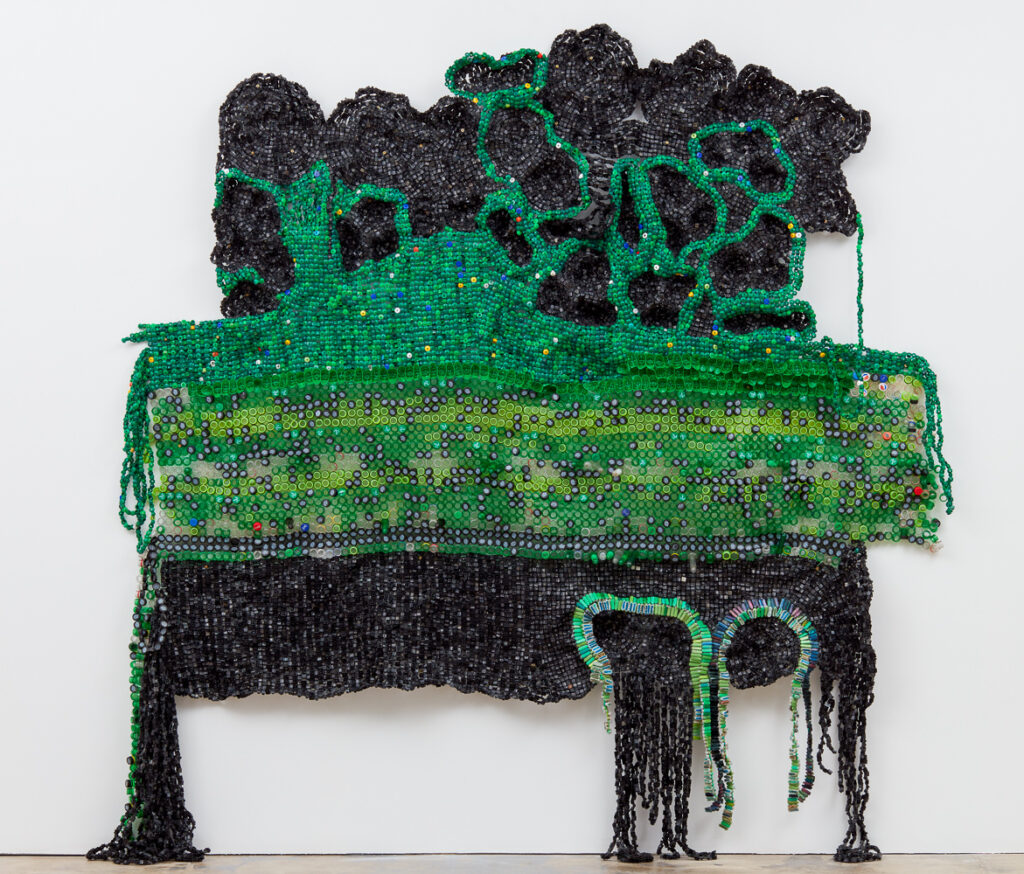
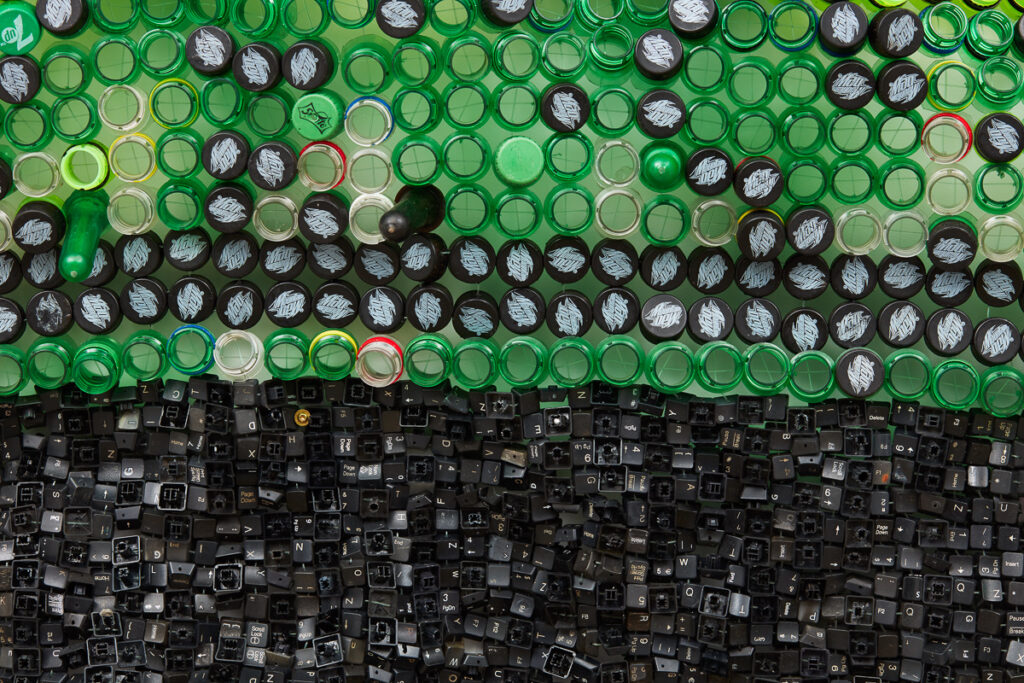

Comments
i want to read this